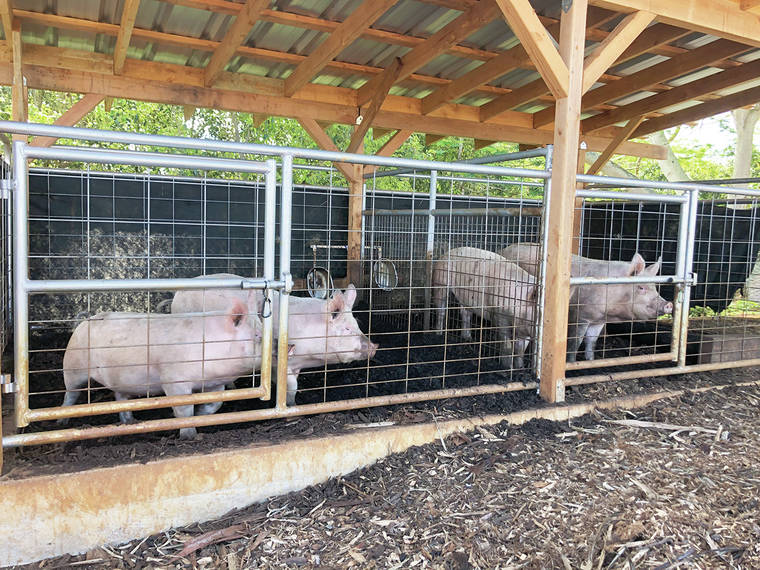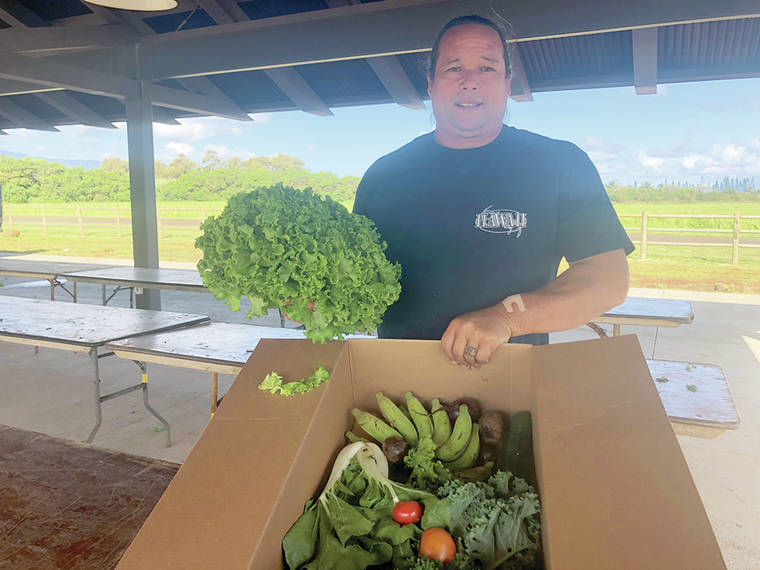KILAUEA — Tuesday morning, staff and volunteers at ‘Aina Ho‘okupu O Kilauea packed and loaded 300 produce boxes into a truck.
The boxes go out across the island, CEO Yoshi L’Hote said, targeting those most in need, by providing vegetables like cabbage, kale, tomatoes and other produce derived from its farms.
During the summer months of the pandemic, the nonprofit was pushing out over 1,000 boxes, purchasing produce from other local farmers. And that’s just some of the work L’Hote has been up to lately.
‘Aina Ho‘okupu O Kilauea received two Innovation Grants from the county recently, one a Kaua‘i pigpen system that will hopefully revitalize the industry, and another grant for new farm technology that can be used on small farms by tracking trends and detecting disease.
While the United States is the third-largest producer and consumer of pork, most operations are concentrated in the Midwest, according to the U.S. Department of Agriculture.
The pen systems currently being used by ‘Aina Ho‘okupu O Kilauea optimize Korean natural farming techniques, a more-environmentally-friendly approach that reduces odors and uses less water.
L’Hote said he learned everything he could from the late Valerie Kaneshiro of Kaneshiro Farms, who also saw value in this technique. However, Kaneshiro used concrete pens versus this Korean natural farming method, which introduces indigenous microorganisms to sustain healthy soil and farming productions. The closing of the 100-year-old Kaneshiro farm in 2019 left the island without a large-scale commercial hog farm.
“The system can be close to houses, and it doesn’t smell. It’s not abrasive,” L’Hote said. “Of course, it’s with the right density, adding mulch when appropriate, making sure your water system works. We feed them only grain. We don’t do slop.”
The idea, and hope, is to create a system of satellite pens to increase production by having various places for piglets to grow to market size and circle back to ‘Aina Ho‘okupu O Kilauea to be either further incorporated in the breeding stages or for processing.
Innovation Grants
Revitalizing the hog industry is just one of 11 projects funded by the county Office of Economic Development, which recently allocated $500,000 in grants.
The grant process included community feedback throughout the month of February, where commentators could rate the priority of the projects, which OED Director Nalani Brun said helped the county with its evaluation.
“This was the first year for the innovation format, and it is something we expect to improve on in future years,” Brun said. “One example — we anticipate a longer response period next year to give applicants time to work on developing partnerships.”
Brun said in the future she hopes to set up a process that allows applicants to get community feedback prior to submitting grant applications.
“It was clear that the community wants to continue to move the needle in agriculture,” Brun said. “This is nothing new, but this process allows us to engage old and new partners to keep trying to move ahead in this area.”
The county awarded seven grants focused on agriculture.
“These grants range from instruction on indigenous methods of kalo farming, microbial development, Hawaiian language, history and cultural practices via a COVID-safe, online platform direct to farmers who may not have access via traditional routes, while on the other edge of the spectrum a grantee will introduce Korean natural farming methods into Kaua‘i’s production systems,” Brun said.
The other grant ‘Aina Ho‘okupu O Kilauea received is also ag-related, and will go toward FarmTech that’ll be used to track weather and detect disease among crops.
Using a drone, a weather station and other technology, the nonprofit can find trends and get a bird’s-eye view of small farms.
“For us, the advantage is that it gives you the data necessary to be able to grow your crop better, and it gives you the ability to have a better eye on your farm,” L’Hote said.
“And the more data collections we do, the more we understand how climate change is moving, the more we’ll be able to target the crops that are doing better, get rid of the cops that don’t work, and be able to be more resilient,” he said.
Brun hopes to see more proposals that push the boundaries like this.
“A larger, ongoing challenge is helping our grant applicants to really understand what we mean when we ask them for ‘innovation,’” Brun said.
“The intent of this grant funding is for applicants to find new and different ways to try to solve local problems. That might mean bringing in new tools for businesses, or innovative ways to deal with waste, or any number of other solutions. Not all of these proposals are guaranteed to succeed — but that is exactly the point.”
Innovation, Brun said, “is risky, and we want to help people reduce that risk.”
Additional grant winners include, by type:
• Agriculture: Kaua‘i Economic Development Board — Ulu: Fruit to Flour; Kumano Ke Ala — KIKA Online Instruction Project; Garden Island Research, Conservation & Development — Iwikua – Greens & Things; Kaua‘i County Farm Bureau and Lydgate Farms — The Kaua‘i Vanilla Partnership Program;
• Sustainability & Conservation: WAI.org — WAI Wastewater Alternatives;
• Small Business: Kaua‘i Government Federal Credit Union — Lei Kaua‘i – Collaborative Learning Environments; Hawai‘i Technology Development Corporation via Kaua‘i Chamber of Commerce – Kaua‘i Business Recovery Project;
• Technology: Kaua‘i Community Science Center — KCSC Industry Partnership Program.
Grantees are assigned a grant manager in the OED to provide quarterly reports to. Final payments of funding will only be made after the grantee completes the project and submits project documentation, including a project outcome and financial report, Brun said.
•••
Sabrina Bodon, public safety and government reporter, can be reached at 245-0441 or sbodon@thegardenisland.com.




This could backfire on farmers. Once the government subsidies stop who will buy the farmers products. In a free market only products in demand sell. It’s easy to give away anything. Not everyone has the same taste. This encourages farmers to grow what’s easy and maybe not what people will want and buy. Government picking winners and losers is not a good idea. Farmers should grow what people want, not just anything the government will buy to give away.
What a breath of fresh air, nobody! And exactly correct. Government interference distorts markets all to the detriment of those it purports to help. Paraphrasing an old saying: he who takes the king’s schilling, becomes the king’s man. Just like the sugar companies here did.
Now, if only people would acknowledge the effect this same interference plays in the lack of affordable housing.
RG DeSoto